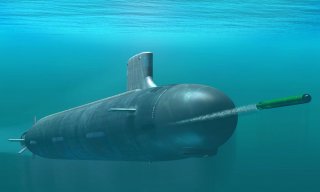Block V Virginia-class Submarines: The U.S. Navy's Best Stealth Sub?
Block V Virginia-class Submarines is getting some extensive upgrades. Russia and China should take notice.
Designed for use in both the open-ocean and for littoral missions, which include anti-submarine warfare (ASW) and intelligence gathering operations, the U.S. Navy's Virginia-class nuclear-powered cruise missile fast-attack submarines (SSNs) were developed to replace the more expensive Seawolf-class while still providing a capable boat to address nautical threats from near-peer adversaries in the 21st century.
The Virginia-class subs combination of stealth, endurance, mobility and firepower has enabled the vessels to support five of the U.S. Navy's six maritime strategy core capabilities including sea control, power projection, forward presence, maritime security and deterrence. The SSNs have a fly-by-wire ship control system that also provides improved shallow-water ship handling, while this class of subs was designed to deploy special operator forces including Navy SEALS. A reconfigurable torpedo room can accommodate a large number of SOF and all their equipment for prolonged deployments and future off-board payloads.
To date, nineteen of the planned sixty-six Virginia-class submarines have been completed, while eleven more are now under construction. Ten of those are from the Block IV, while one is from the latest Block V – and that latter boat will feature key improvements that enhance the capabilities of the fast-attack subs.
Numerous Improvements
All of the Block V submarines will be equipped with acoustic superiority improvements, which the Navy has seen as crucial to maintaining design superiority over Russian and Chinese submarines. The overall design will differ from the Block IV boats by approximately twenty percent, according to a Congressional Research Service (CRS) report.
The Block V submarines are larger than the previous versions, with the length increased from 377 feet to 460 feet, and with greater displacement from 7,800 tons to 10,200 tons. As a result, the Block V versions of the Virginia-class are the second-largest U.S. submarines produced behind only the Ohio-class. This added eighty-three-foot section is to increase the number of missile launch tubes – increasing the number from twelve to forty, which in essence could triple the capacity of short targets for each boat.
As part of the Virginia Payload Module (VPM), this extended mid-body section can be used to store and fire additional Tomahawk cruise missiles and other payloads; including large-diameter unmanned underwater vehicles (UUVs). It also increased the number of torpedo-sized weapons carried by each submarine from about thirty seven to about sixty-five, an increase of seventy-six percent.
While this has greatly increased the estimated recurring unit procurement costs of the Block V boats to roughly $3.4 billion, it comes with those numerous improvements and upgrades, and these latest subs could serve well into the 2070s and beyond.
The CRS report noted, "Building Virginia-class boats with the VPM is intended to compensate for a sharp loss in submarine force weapon-carrying capacity that will occur with the retirement in FY2026-FY2028 of the Navy's four Ohio-class cruise missile/special operations forces support submarines (SSGNs). Each SSGN is equipped with 24 large-diameter vertical launch tubes, of which 22 can be used to carry up to 7 Tomahawks each, for a maximum of 154 vertically launched Tomahawks per boat, or 616 vertically launched Tomahawks for the four boats. Twenty-two Virginia-class boats built with VPMs could carry 616 Tomahawks in their VPMs."
Construction of the ten Block V subs was scheduled to begin in 2019 but was pushed back to 2020. Contract delivery of the first Block V submarine is FY 2025.
Peter Suciu is a Michigan-based writer who has contributed to more than four dozen magazines, newspapers and websites. He regularly writes about military small arms, and is the author of several books on military headgear including A Gallery of Military Headdress, which is available on Amazon.com.


